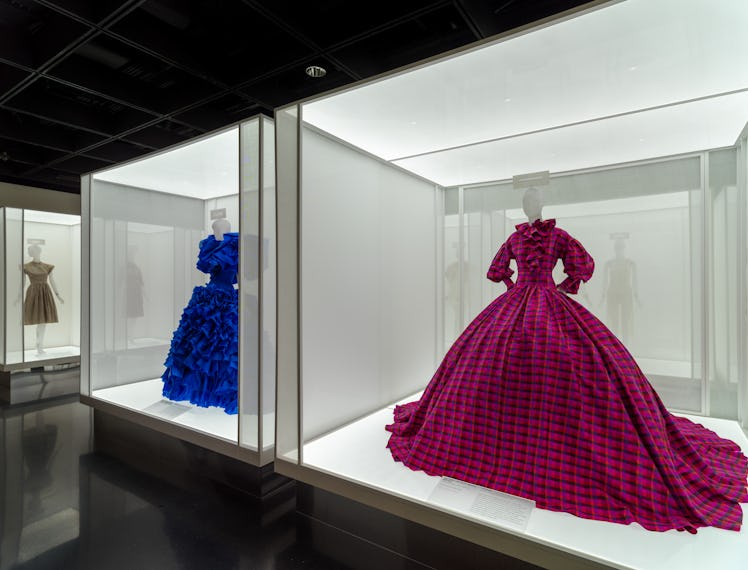The Met Costume Institute Patches Together a Story of American Fashion
The exhibition showcases designs by 20th century legends and contemporary icons in a scattered array.

The exhibition In America: A Lexicon of Fashion, at the Metropolitan Museum of Art’s Costume Institute, opens with a quote from Jesse Jackson’s speech at the 1984 Democratic National Convention: “America is not like a blanket—one piece of unbroken cloth, the same color, the same texture, the same size,” it reads. “America is more like a quilt—many patches, many pieces, many colors, many sizes, all woven and held together by a common thread.”
The first room of the show suggests that the curators have taken this quote quite literally: patchwork designs in denim and calico by Ralph Lauren, Bode, Stan, No Sesso and others are displayed one on top of the other around Sterling Ruby’s “Veil Flag,” and an Egyptian sarcophagus. This is the “Nostalgia” section, which, along with the sentiments of “belonging, delight, joy, wonder, affinity, confidence, strength, desire, assurance, comfort, and consciousness” is presented as a defining vocabulary of modern American fashion.
As you continue your journey through the rest of the exhibition, which was curated by Andrew Bolton and celebrated with last night’s celebrity-studded Met Gala, the quilt as organizing principle becomes more obvious. Most of the 100 ensembles—save for a pair of dynamic dresses by Gypsy Sport and LRS; and a set of American flag sweaters—are displayed in grid-like fashion within partially scrim-walled cubes, making up a stitched-together, varied array. This is part one of a two-part examination of American fashion, which will run for a full year. The second half, “An Anthology of Fashion,” which opens in May, will be displayed in the museum’s Period Rooms and include video elements.
A section called “Assurance” draws a visual connection between everyday camel-colored pieces and show-stopping gold sequins. From left: a 1972 ensemble by Norman Norell, a look from Michael Kors’s 40th anniversary fall/winter 2021 collection, a Marc Jacobs spring/summer 2020 dress.
In Part One, there are moments of the sublime to be found, but anyone looking for a clear historical narrative or thesis will be disappointed. Aside from short blurbs at the base of each individual look and punchy, individual words at the crown of each mannequin, there is no text to guide or inform. The effect feels more like flipping through a series of magazine editorials than attending a museum show: While the visual unity of each section is apparent (there’s a row of cozy, piled-on knits by the likes of The Row and Gabriela Hearst; another that charts a course from neutral beiges to gold sequins; another that looks at workwear from 1940s women’s suiting to a Department of Sanitation uniform by Heron Preston; another, devoted to the evolution of collegiate prep, starts with Perry Ellis and ends with Pyer Moss) any deeper connection between the looks—in terms of shared technique, inspiration or cultural context—gets lost.
The designers featured include 1990s legends like Isaac Mizrahi (one babydoll dress, from the spring/summer 1994 collection, might be familiar to fans of the documentary Unzipped), Calvin Klein, and Donna Karan as well as earlier 20th century artisans, such as the uniform manufacturer Main Bocher and the 1940s gown whisperer Charles James. In equal representation are the emerging talents of the moment: Vaquera, Collina Strada, Conner Ives, Christopher John Rogers. One surprising highlight, at the center of a line of frilly pink outfits, is two contemporary dresses by the self-taught, 23-year-old designer Olivia Cheng, whose label Dauphinette makes use of preserved flowers encased in resin. But beyond a feminine color palette, it’s difficult to understand how her work relates to the voluminous Marc Jacobs number and vintage Anna Sui frock that flank it.
A refreshing surprise: Two dresses by the self-taught, 24-year-old designer Olivia Cheng, whose label Dauphinette makes use of pressed flowers encased in resin and silk organza.
Arguably the two biggest topics of discussion in the global fashion industry right now are size inclusivity and sustainability, the latter of which was addressed by the “Consciousness” room, which included a series of upcycled and re-worked looks by upstarts, streetwear designers, and vintage dealers. But the attempt to showcase a conversation around clothes designed for people who don’t wear a sample size, especially when the average American woman wears between a size 16 and and 18, is almost laughable. Three black Christian Siriano cocktail dresses, which were part of the finale of his spring 2018 runway show and worn there by models of different shapes and gender identities, were displayed on a trio of mannequins with long spindly legs, the difference between their dimensions almost impossible to discern without squinting.
A nostalgic look by Ralph Lauren.
A pink babydoll dress from Isaac Mizrahi’s fall/winter 1994 collection.
The definition of a lexicon implies a complete set. Without it, the central features of a language cannot be understood. But by omitting everyday vernacular—in this case, the clothes that make up the fabric of American life—it’s difficult to make sense of. Where are the cotton jersey and denim and spandex that most of us pull on everyday? Sure, they wouldn’t look that exciting in a vitrine, but there are creative ways to present such ephemera. What about traditional indigenous costumes? Painstakingly constructed rodeo garments? Honestly, I would have loved to see a velour Juicy Couture tracksuit somewhere in the mix. The story this exhibition tells is an elegant one, but presenting it as a wide-ranging vocabulary list is like saying the only things worth reading are mile-high philosophical anthologies, while ignoring the discourse that takes place on more democratic platforms, like the internet. The other stuff is just as essential—it provides the texture that makes getting dressed exciting.
This article was originally published on